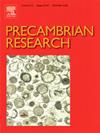During the Precambrian − Cambrian transition, the occurrence of phosphogenesis and the rise in atmospheric oxygen levels are closely linked to the proliferation of life. However, the mechanisms associated with these phenomena and their underlying causes are not well understood. The Irecê Basin represents the remnants of intracratonic marine environments that document the Neoproterozoic sea flooding of West Gondwana. This study presents an integrated analysis of sedimentary facies and chemostratigraphy through high-resolution sampling of pristine limestones and dolomites from the Salitre Formation in east-central Brazil. The aim is to explore the relationship between environmental settings and phosphatized stromatolites by combining detailed facies descriptions with isotopic and geochemical data. A total of fifteen lithofacies types are identified and grouped into seven major facies associations. These associations reveal a depositional stacking pattern defined by flooding surfaces and transgressive–regressive cycles, allowing for the division of the Salitre Formation into two depositional sequences. The basal sequence includes sedimentary phosphorite deposits intimately associated with widespread dolomitization levels at the top. Here, we describe a combination of two major processes for the dolomitization model of the Salitre Formation, with a contribution of evaporative environment settings related to a sabkha, and the influence of a meteoric mixing zone. Furthermore, three stages of phosphogenesis have been identified, with two of them interpreted as early diagenetic deposition associated with stromatolites and early cementation, and the last one associated with a late stage of phosphogenesis. The combined analysis of REY patterns, 87Sr/86Sr ratios, and geochemical results suggests a significant continental influence on both dolomitization and phosphogenesis. The identification of depositional settings and stratigraphic patterns for these deposits is crucial for the understanding of phosphogenesis during the Ediacaran, which may have been influenced by the continentalization of the marine environments forced by the intracratonic marine setting and the tectonic evolution at the end of the Neoproterozoic Era.


